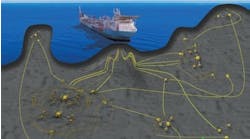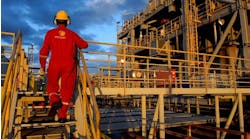Anne-Marie Walters
Bentley Systems
Deepwater Wind, a Providence, Rhode Island-based offshore wind developer, undertook the $290-millionBlock Island Wind Farm project to supply less expensive power to Rhode Island. As the first commercial wind farm in the United States, the project demonstrated the feasibility of offshore wind as an alternative energy resource for US coastal cities. Keystone Engineering (Keystone) was retained to design jacket-type substructures for the five, 6-megawatt wind turbine generators.
Keystone used Bentley Systems’ SACS software to streamline communication with the generator designer (Alstom), and to model the complex aerodynamic and hydrodynamic loading profile for the deepwater platforms. Bentley’s flexible, interoperable offshore design and analysis software shortened the design cycle time by enabling the design team to create simultaneous simulations for multiple design iterations, and helped reduce installation costs by optimizing the substructure design for weight and strength.
Onshore wind already represents a $100-billion investment in the US. Offshore wind has the added advantage of tapping stronger, more reliable wind resources than onshore wind farms. Deepwater Wind advocates the use of offshore platform technology proven in the oil and gas industry to build wind farms in deep waters miles offshore, where they are barely visible from land yet still close enough to serve major population centers.
Taking the lead from successful offshore wind farms in Europe, the developer saw an opportunity to provide cost-competitive energy from wind offshore Rhode Island. The Block Island Wind Farm is located 15 mi (24 km) from the US mainland and 3 mi (5 km) offshore Block Island. It will supply 30 megawatts of power to about 17,000 homes on Block Island via a subsea cable. Due to the otherwise high cost of electricity on the island - currently four to five times higher than in other US locations - the offshore wind farm is projected to reduce energy costs for Block Island residents by 40%, as well as reduce carbon dioxide and other emissions.
The challenge for the team designing the dynamic wind turbines involved compensating for the complex loading onto the support structures by both wind and wave action. The design needed to account for the coupled effects of the aerodynamic and hydrodynamic loading, including extreme loading situations such as turbine control faults and hurricane-force winds. To calculate the loads, model the fatigue performance, and engineer the platforms to withstand various load combinations over a 20-year design life, the Keystone team used SACS, Bentley’s offshore design and analysis software.
As an innovative solution for the design of the deepwater wind turbine support structures, the engineering firm adapted the steel jacket foundation design typically used in the oil and gas industry. SACS enabled Keystone to design the composite construction and complex nodal geometry of the jacket substructures, delivering an alternative to the typical monopile concrete foundations that are limited to offshore wind farms located in more shallow-water depths.
To collaborate with the turbine generator designer, the company relied on SACS’ functionality for interfacing with DNV GL’s Bladed, a wind turbine simulation tool. This allowed the team to optimize the design of the total structure and ensure safe operation. The SACS-Bladed interoperability enabled the transfer of simulation model data, ensuring that the models matched.
Working on five, 24-core computers running 24 hours-a-day for 10 days, the design team conducted 2,334 simulations, 30 million time steps, and 25 load cases (including operating, storm, start-up, shutdown, fault, maintenance, and installation) for waves of up to 19 m (62 ft) high and winds from eight directions at speeds from 2 m/sec to 58 m/sec (7 ft/sec to 190 ft/sec). SACS enabled Keystone to streamline the design and analysis of the simulations, and accurately manage terabytes of project data to minimize the possibility of errors.
Using the software, the engineering company performed more than 3,000 time-domain simulations for each design iteration, and conducted more than 150 simulations in parallel, reducing cycle time by 50% compared to typical European offshore wind projects. The SACS-Bladed functionality was also used for tuning the frequency of the structure so that it can operate at a wide band of wind speeds and oceanographic conditions, maximizing revenue. An avoidance band in the operating speed of the turbine could cause losses of production up to 50% over the lifetime of the turbine.
Keystone leveraged the technology developed for the offshore oil and gas industry to meet the complex design criteria for the jacket foundations.
The iterative process optimized the jacket design and reduced the amount of steel needed for the substructure, while still ensuring a design life of more than 20 years. As a result, the Block Island Wind Farm jackets are 15% lighter than a previous design used for the same type of wind turbine in the North Sea. The optimized design also reduced installation costs by more than 20% compared to traditional monopile construction and can survive hurricane-force winds.
Bentley’s comprehensive, interoperable software ensured effective collaboration with the wind turbine designers, facilitating the accurate modeling that produced innovative design solutions throughout the project.




